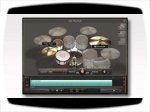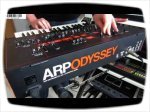ARC - Advanced Room Correction System
Sep 8, 2008
A good mix. In today's audio world, it's not just something nice to have. It's a MUST. If you want to make a good mix of either music or sound for film, you have to go to a professionally designed studio, or acoustically treat your project studio. Now, with IK Multimedia's ARC (Advanced Room Correction) System, there is a third option- a software plug-in. It seems that there is a plug-in to fix everything under the sun these days, so why not have one that corrects the room tone in your studio?
| INTRODUCTION | |
-
IK Multimedia has made a bold move forward in creating a plug-in ($599 Street Price or $449 for registered IK Multimedia Users) that does what thousands of dollars of professional testing and treatment would do: properly tune your room. But is this a solution that replaces the need for proper room acoustic treatment entirely, or is this just another case of hype over substance? Or is it somewhere in between?
 Read more articles at AudioMIDI
Read more articles at AudioMIDI
In this article, I, along with Sabi Tulok, a sound engineer colleague who specializes in sound design for film, will dispel the current mystery of the ARC System. I used a setup typical of most beginners in the audio world… a basic project setup in a loft/den with no acoustic treatment on the walls at all. Sabi performed his evaluation in a professional setting in a commercial editing studio. The goal of this ARC review is to inform the readers to form their own conclusions of whether this new technology is right for their particular situation and needs.
| ARC Reviewed by : David Graveline | |
-
Studio: project studio in a loft of a 2-story house
Room: 11W x 14L loft with a slanted ceiling, no acoustic treatment on walls, carpet
Gear Setup: Digi 002 Rack, Pro Tools LE 7.3, Event 20/20 monitors, MacBook Pro Intel Dual Core 2.2Ghz (2G RAM)
Test Material: Piano & Vocal
| INSTALLATION | |
-
On my MacBook Pro (or any desktop or laptop computer, really), installation is ridiculously easy. Anyone able to read English is able to install the program with just a few clicks of the mouse.
| MEASUREMENTS | |
-
The first step in the ARC Measurement process is to select your inputs on your interface and the outputs going out to your speakers. It is also very important that the audio interface used is set to 48kHz. The program will not let you pass Step 2 until the 48kHz setting is done. (see below)
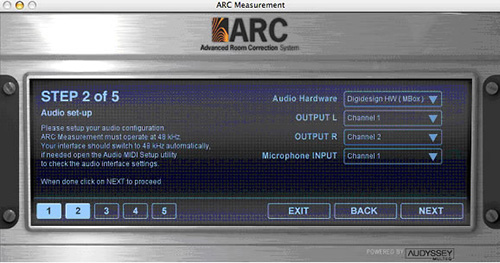
The next step in the process involves testing the signal strength of the sound tests before the actual frequency measurement process.
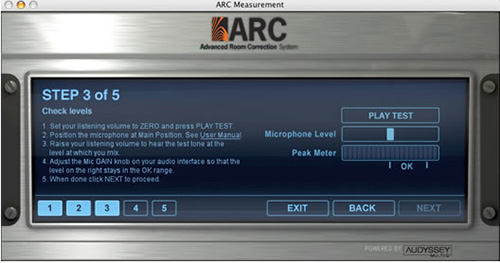
It was at this point here that I realized I could not use my old Mbox since I could not set my listening volume to "Zero" since I had no monitor level knob on the Mbox interface. (By the way, the term "Zero" is quite confusing if you are accustomed to working on mixing boards where "zero" is near optimal volume output. This should be re-labeled as "Volume Off" or "infinity".) So, lucky for me, a friend gave me his Digi 002 Rack to use for this product test. Because the 002 has a monitor level knob, setting the optimal level for the mic test was much simpler a task.
Taking the actual measurements was a bit tedious, but not difficult at all. I did 30 measurements at about ear level (15 at one mic height, and then 15 more at a slightly higher positioning) within a sphere of listening space where I sit at my desk in front of my monitors. Although you only need to take a minimum of 12 measurements, I wanted to take a good deal more just to ensure that I am getting the most accurate reading possible for my listening area. I used bits of paper with numbering on them to keep track of where the mic position has been so that I did not duplicate any previous mic measurements. This is what the floor near my chair looked like with all the measurement paper reminders:
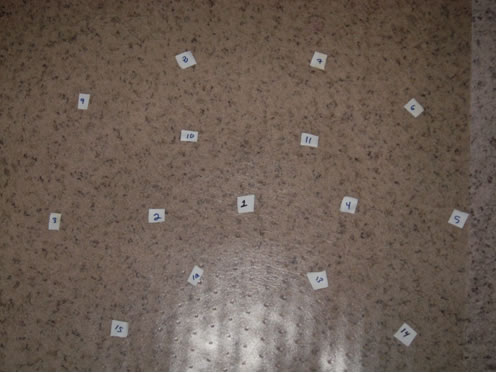
| ARC STARTUP | |
-
When the measurement process is finished, the program calculates an algorithm that you can name as a preset. When I opened the plug-in for the first time, a pop-up screen appeared which allowed me to register the product online and enter my Serial # and Digital ID to obtain the Authorization Code needed to run the program permanently. It is nice to know that with this product, like all IK Multimedia products, no iLok USB key is required. Although I was given an authorization code for the product review, everyone else who buys the product will get their authorization code emailed to them within a 24-hr timeframe, if not almost immediately. Though, even without the authorization code, the plug-in will work for a 10 day demo period.
ARC Measurement Reading of the "Loft Project Studio"
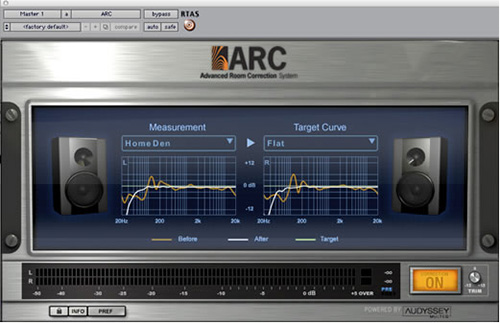
Once you load the plug-in on your Master Fader for the first time, it is obvious that three colored curves show exactly what the ARC plug-in is doing to fix the frequency response of your speakers/room. The orange curve represents the original measured speakers/room frequency response. The white curve shows the corrected response when the ARC plug-in is activated.
And the green curve represents the selected target curve. In the example of my room's readings above, I selected a flat target curve, so that the green line is perfectly flat from 20Hz to 20kHz.
For my speaker/room combination, the orange line shows that the lows below 100Hz were 6db below where they should be if I had a truly flat frequency response. The area between 100Hz and 300Hz was between 6db and 1db above where it should have been. And with the plug-in loaded, you can see by the white line that everything above 80Hz was corrected to achieving a flatter frequency response.
What wasn't so obvious about the graphic was that the two graphs actually represent the left and right speakers. Granted, the left graph has a small "L" on the upper left corner, and the right graph has a small "R" in the upper right corner, but until I looked at the manual to see that these two graphs represented my left and right speakers, the titles above the graphs ("Measurements" and "Target Curve") confused me quite a bit. On their next version of the ARC system, IK Multimedia should make this graphic simpler to understand by placing the Measurement and Target Curve information further away from the graphs themselves.
| ACTUALLY USING IT | |
-
I tested the ARC plug-in on a female vocal piano ballad very similar to a Sarah McLaughlin song. It was a simple song with just piano and vocal tracks. I worked for 45 minutes on the mix with the ARC plug-in on the Master Bus within a Pro Tools 7.3 Session, and de-activated the plug-in when I went to Bounce to Disk to an AIF file. I found the plug-in very easy to use since all I needed to do was to select the pre-set made during the measurement process, and then hit the "Correction On" button. It did reduce the volume output on the Master Bus, but a quick adjust to the trim knob next to the "On" button fixed that issue. (Although I had no trouble with this issue of turning the plug-in on and adjusting the trim knob, a few other people who have seen this expressed dismay… primarily because when you load most other plug-ins, their default mode is automatically "on" and the volume output is exactly the same output as if no plug-in had been loaded.)
After mixing the song using the ARC System plug-in, I could have just stopped there, but I wanted to have some sort of frame of reference. So, I started a new session and started the mix over, this time without the ARC plug-in. After being accustomed to the plug-in being on for almost an hour, I noticed that when I turned it off, that there was a considerable bass boost from the speakers and less presence in the high-mid range even though the overall volume was louder. As I was mixing, I was constantly striving to achieve a better mix than the one I did with the ARC plug-in to see if I could "out-mix" the plug-in! I mixed for about 30 minutes, and then did the exact same Bounce to Disk to an AIFF file.
| THE VERDICT | |
-
So, of course, when both mixes were done, I went to the never-erring "Car Test" and "Crappy Computer Speaker Test." I have just a basic factory-installed stereo in my Saturn sedan which I know quite well having logged about 20K miles per year for 5 years in it. I know how a well-mixed song sounds in both my car and on my laptop speakers, and after putting both my ARC'd and non-ARC'd through both tests, the winner was...drum roll please… the ARC'd Mix!
There was more "mud" around the 250-400hz range in the non-ARC'd mix, and overall it felt less bright and clear. The ARC'd mix lacked the warmth in the bass and low-mid area, but provided a clean, smooth sound in the frequencies above 2K. I later found out that this lack of warmth is addressed in the ARC System manual (Lesson learned: I should have read the manual THOROUGHLY before I started!), and that is why IK recommends trying out the High Frequency Roll-Off or the Mid-range Compensation Target Curve Settings. However, because I didn't have the time to do other target curve settings in this review, I must base my evaluation off of the Flat Target Curve. In the car, I liked the non-ARC'd mix because of the bass response, but on the laptop speakers it sounded far too muddy.
So, in terms of clarity, the ARC'd mix won hands down. In terms of overall sound, one has to decide whether they prefer a darker of brighter mix. Moving forward with using the ARC System, it will be interesting to find out how it sounds on a more complex arrangement of 30 or more tracks in a rock or pop song. Will the lack of warmth be even more apparent or not? Further testing on my own is definitely needed!
Take a listen to the two audio samples below. In the first sample, you can hear that the mix sounds clear and bright. You can hear the subtleties in a few piano trills before the vocal comes in. When the vocal comes in, it sonically "sits" separated from the piano. In the second sample, you'll hear a darker overall tone, and the intro piano trills are not as clear. This time, when the vocal comes in, there sounds like there is a bit of an overlap between the vocal and piano.
Mix With ARC :
Mix Without ARC :
Ultimately, this is a classic example of "Do you prefer vanilla or chocolate?" The ARC plug-in has characteristics that will, indeed, change the frequency shape of your mix, but you cannot qualify the plug-in as bad or good; just different.
You must familiarize yourself with the new sound coming out of your "ARC'd" speakers just as you would for any new speakers you would use. For me personally, since I have no acoustic treatment in my room, and my Event 20/20 monitors are not my ultimate monitors of choice, I will definitely use the ARC plug-in for rough mixing in the euphemism of my "room" before I bring the mix into a professional studio for final touches. Now that I understand that the ARC System lowered the low-mid response from my speakers, I will make the necessary changes in the lower end of the frequency spectrum to bring back "warmth" if I so desire it.
| ROOM FOR IMPROVEMENT | |
-
The ARC System tunes your speakers relative to your room, but it does have room for improvement. The following four points address where improvements can be made.
| MEASUREMENT PROCESS | |
-
1) Both the manual and the program screen shot should mention to bring down your volume completely down to start the measurement process…NOT to bring it to Zero. The term "Zero" is misleading. "Zero level" on most modern mixing boards means all the way up and would simply be too loud to monitor the test at.
2) There should be some way to do the frequency measurements in conjunction with an older Mbox. Since it does not have a Monitor Volume knob, you cannot adjust the volume of the measurement signals emitting from the speakers unless there is a Master Fader up within Pro Tools. It seems that IK Multimedia is missing a considerable market share of individuals who are using the old version of the Mbox as their sole interface in a project studio environment. It is precisely these people who need the ARC System the most. Please keep in mind, though, that this is a problem with the Mbox, and not with ARC. All versions of the Mbox 2 have a Monitor Volume knob that is fully compliant with the ARC System.
3) The labels of Measurement and Target Curve should be placed somewhere else (perhaps in the large metallic-looking area where it says "ARC" at the top) so as to clearly indicate the left and right speaker graphs.
4) The Volume output of the ARC should be louder in order to be closer to the normal output signal of the DAW.
Other than these four points above, the eye-pleasing GUI, the ease-of-use, and the practicality of the application as both a device to measure frequency response and a mixing tool for all major software DAWs, make this quite an attractive product.
| So, Who Should Use the ARC System? | |
-
There are those engineers and producers out there who have spent thousands of dollars tuning their rooms and having them professionally designed and acoustically treated. The ARC System, while helpful in the further tuning of these rooms, is not the "must have" ideal mixing tool for these people who are already accustomed to their rooms and speakers. It has a far more important role for three other groups of people:
1) Everyone mixing in an acoustically untreated room (or partially-treated room)
2) Those who are familiar with, and happy with, their current speakers/room environment. (They can simply take the measurements and create a preset for the plug-in, and then use these findings to acoustically treat their rooms. That way, you get the benefit of the device solely as a measurement tool without messing with the output of the speakers.)
3) Any freelance engineer who travels and mixes in different rooms and environments
| CONCLUSION | |
-
The ARC System, priced at $599 ($449 for the Cross Grade) is a relatively minor expense compared to professional acoustic treatment. There are not too many completely perfect listening environments out there. And for the masses of people who work from home or a project studio, the ARC System is an extremely useful tool.
IK Multimedia makes lofty claims on how this plug-in will "improve clarity, stereo imaging and frequency response, for faster, more reliable mixing." The ARC system does not simplify the mixing process where you will not need any important cross-reference speaker tests, but the clarity it provides will enable you to minimize the number of tweaks and adjustments needed. In that respect, I tip my hat to IK Multimedia for reducing the number of CD-R's burned and wasted. In the end, proper listening is the key ingredient to obtaining a great-sounding mix. ARC helps provide the clarity, but the rest is up to you.
| ARC Reviewed by: Sabi Tulok | |
-
Studio: Soundasart Studios- Sherman Oaks, CA
Room: 14'L x 13'W x 9'H with APS acoustic panels and placed 8-10"apart and about 4 feet above the floor, carpet
Gear Setup: Avalon Vt 737sp preamp, D-Command console, Event SP8 Active monitors (5) Genelec 7070A Subwoofer, Apple G5 Dual Core (4gb memory)(2gHz CPU) Digidesign Pro Tools HD 3 –IO 192
Test Material: Short Indie Film
| Introduction | |
-
We all know how much money and time it takes to buy acoustic treatments for our studio walls and corners and hire someone to do a professional installation. Now with the ARC System, and any monitors of your choice, a studio can be tuned just in minutes. After measuring the room at all the critical listening areas (where engineers and clients sit), the software then combines this information to provide an accurate representation of the room's acoustical problems. The correction plug-in corrects time and frequency problems very effectively.
| Installation and Measurements | |
-
The ARC System comes in a neat box with a CD, manual, and of course, a microphone. Installation of the software is really easy. After opening the application you need to indicate the interface inputs and the outputs for the speakers. For the mic setup, after following the instructions to set the correct mic level and setting your interface at 48kHz, you are ready to do some measuring.
The instruction booklet explains how and where to set the microphone. Positioning is very important. You can do up to 32 measuring in one listening area. Then you can start over and do another set of measurements somewhere else. Make sure to cover all the areas where someone will be doing critical listening. After each set of measurements you can name and save the results (ie: main position, back of the room, at couch, etc). When you are done, open your editing (mixing) software and open the ARC plug-in on your Master Bus. Within the plug-in, you can select the saved preset you just made. Now you can see (and later hear) the difference between your room's and the corrected frequencies.
To check your mix with or without correction, you can turn the plug-in on and off. There are then 4 different curves to choose from to correct your room to. Do your mix with the plug-in, but turn it off when bouncing the mix. Cross reference your mix in different listening devices (home stereo, surround system, car stereo etc.) to make sure you have an accurate and great-sounding mix, whether it is music, a film soundtrack, or anything else.
Measurement Reading at Soundasart Studios
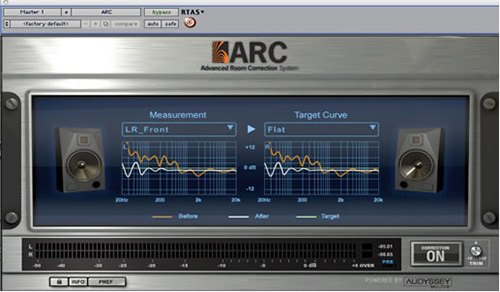
| Initial Impression and Actually Using It | |
-
I was about to mix an interesting short film, so this was a great opportunity to try the ARC system.
As I opened the plug-in on the master channel and started to mix, I noticed right away that some of the low-end frequencies were reduced to a point where it was a little too much for my taste. I had to EQ the dialogue track to make it more intelligible by adding 200-500mhz with a gain of 2db, just to compensate for the lack of lows that I missed. The overall volume level was lower than I needed, so a little more limiting helped to compensate for it. I usually normalize the final mix anyway to bring it to the desired level. After checking the final mix on a TV set (stereo), it sounded good. The mix was good enough for me to use the software until we install additional wall treatment and fix all the frequency problems. From then on, I will be able to trust the room.
| Room for Improvement | |
-
TDM is not supported. So it takes up some CPU power which can slow your DAW down, especially when you use a lot of RTAS plug-ins.
| The Verdict | |
-
Is it worth it to buy a $600 correction software? If you are working from your bedroom, basement, or something other than a professional studio, it is a great deal. You don't have to spend a fortune on wall treatments (if you don't own your house, the owner might not want you to do anything to the room anyway). This software does it for you.
For pro studios, it is a good idea to have measuring software to detect problems in the room. Then, do the necessary acoustical treatment so that the fix is permanent. It wouldn't be cheaper, but in my opinion, a great sounding room is better than any correctional software can replicate.
Overall I liked the easy installation, easy to follow instructions, and the good job it does at measuring the room. It was well worth the time to do the measurements to get a confirmation of how Soundasart Studios sounds (and should sound).
| So, Who Should Use the ARC System? | |
-
Anyone who has or will have a studio; anywhere from a bedroom-based project studio to a professionally built one that needs acoustic treatment to calibration of existing ones. You can achieve a great sounding mix without spending a fortune. IK Multimedia's ARC System is the best, affordable quick solution for room acoustic problems-- at a fraction of the cost of professional acoustic treatment.
This article has been proposed to you by MacMusic in association with AudioMIDI
 AudioMIDI is a leading US relleser who also provides great information about a plethora of products commercially available for creating and recording music with a computer.
AudioMIDI is a leading US relleser who also provides great information about a plethora of products commercially available for creating and recording music with a computer.| Reader's opinions | |












